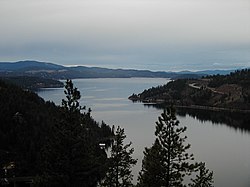Lake Coeur d'Alene
| Lake Coeur d'Alene | |
|---|---|
 |
|
| Location | Kootenai / Benewah counties, Idaho, U.S. |
| Coordinates | 47°32′00.46″N 116°48′32.84″W / 47.5334611°N 116.8091222°WCoordinates: 47°32′00.46″N 116°48′32.84″W / 47.5334611°N 116.8091222°W |
| Type | glacial, reservoir |
| Primary inflows |
Coeur d'Alene River, Saint Joe River |
| Primary outflows | Spokane River |
| Basin countries | United States |
| Max. length | 25 mi (40 km) |
| Max. width | 3 mi (4.8 km) |
| Surface area | 49.8 sq mi (129 km2) |
| Max. depth | 220 ft (67 m) |
| Water volume | 2,260,000 acre·ft (2.79 km3) |
| Residence time | 0.5 years |
| Surface elevation | 2,125 ft (648 m) |
Lake Coeur d'Alene is a natural lake in northern Idaho, in the northwest United States. Its northern end is in the city of Coeur d'Alene. It spans 25 miles (40 km) in length and ranges from 1 to 3 miles (5 km) wide with over 109 miles (175 km) of shoreline.
Lake Coeur d'Alene, like other lakes surrounding the Spokane Valley and Rathdrum Prairie, was formed by the Missoula Floods, most recently 12,000 to 15,000 years ago. The Purcell Lobe of the Cordilleran Ice Sheet flowed south from Canada, carving the basin of present-day Lake Pend Oreille and damming the Clark Fork river. The impounded river repeatedly filled to form Glacial Lake Missoula and broke through the ice dam, resulting in massive floods that filled the Rathdrum Prairie area with sand, gravel, and boulders. Large eddy bars formed downstream from bedrock obstructions, thereby damming tributary valleys and creating lakes. Lake Coeur d'Alene is fed primarily by two rivers, the Coeur d'Alene and the Saint Joe. The outflow is via the Spokane River.
The lake's elevation varies from 2,128 feet (649 m) above sea level in the summer to up to 7 feet (2.1 m) lower in the winter, controlled by the Post Falls Dam 9 miles (14 km) below the lake on the Spokane River.
The lake's average surface temperature between June 1 and September 30 is 68 °F (20 °C).
The first-recorded European to see the area was explorer David Thompson in 1807. The lake has been used for transporting lumber by water in Kootenai County since the timber industry started in the region. Prior to a fire in 1917, Harrison was planned as the county seat of Kootenai County, as the swiftly growing lumber town was at an opportune junction of the St. Joe and Coeur d' Alene rivers. After the fire, the mills were moved mostly to the city of Coeur d'Alene, which developed more and was designated as the county seat.
...
Wikipedia
